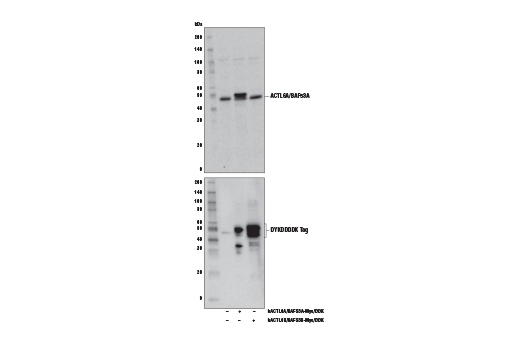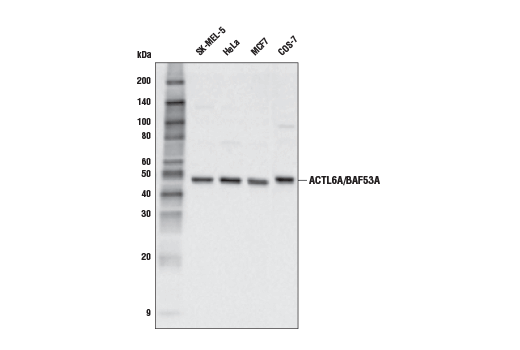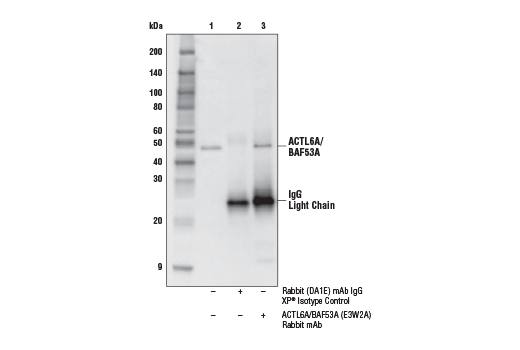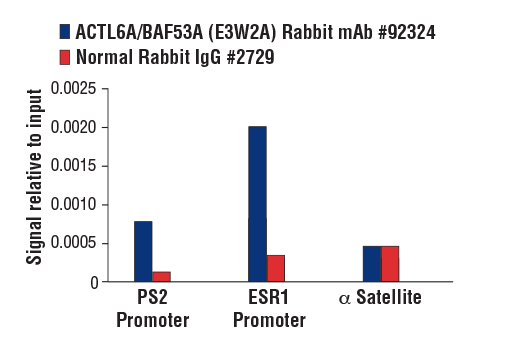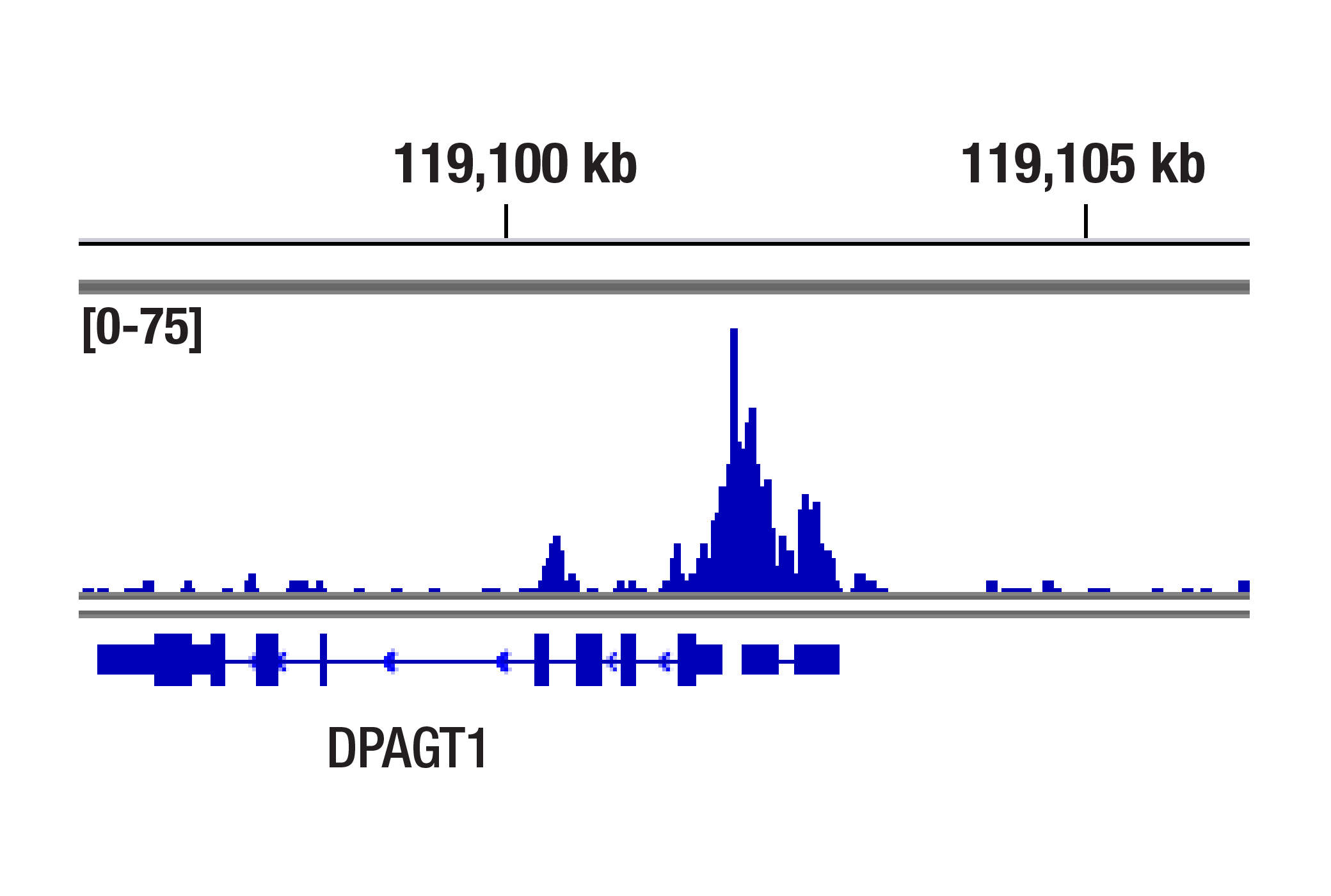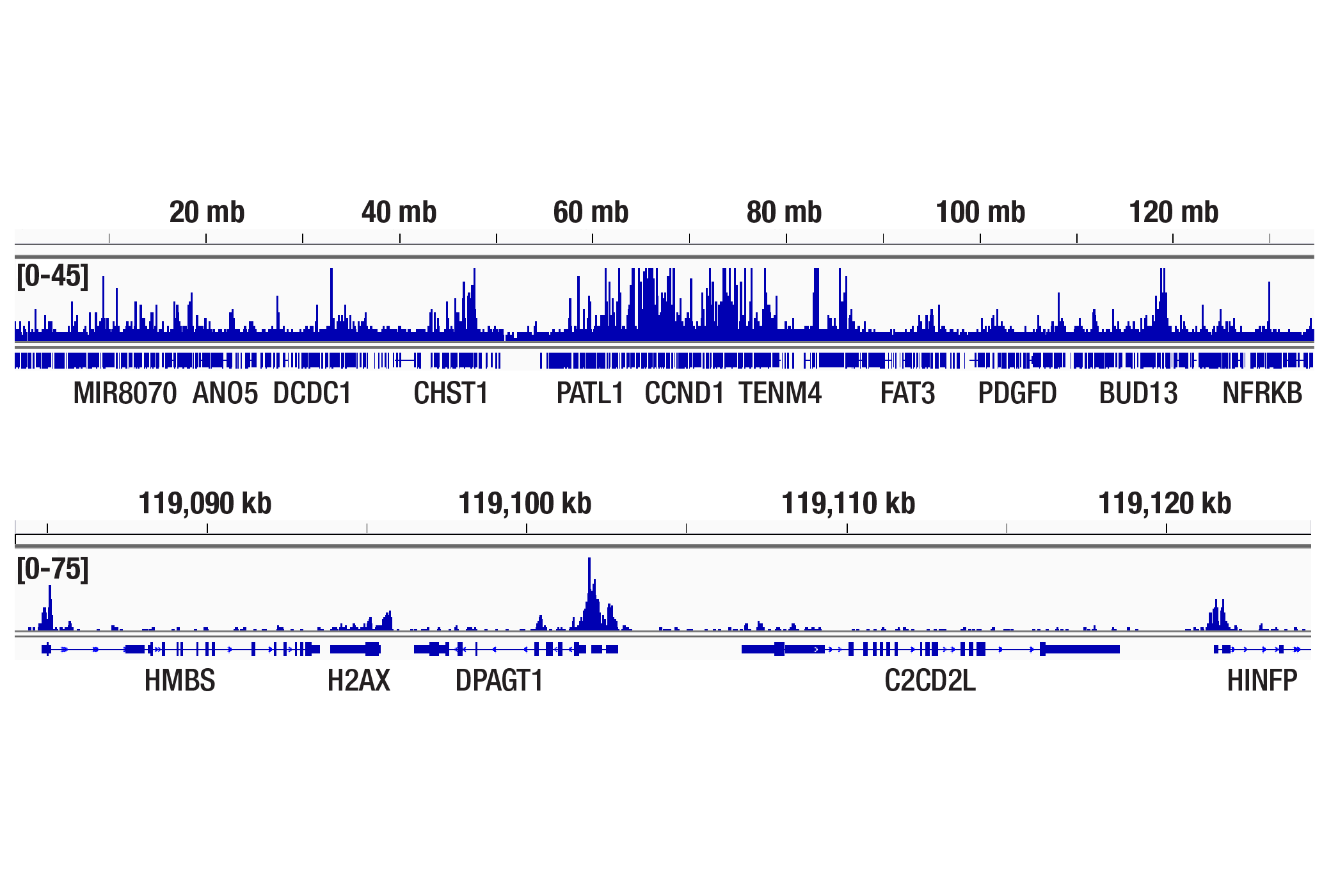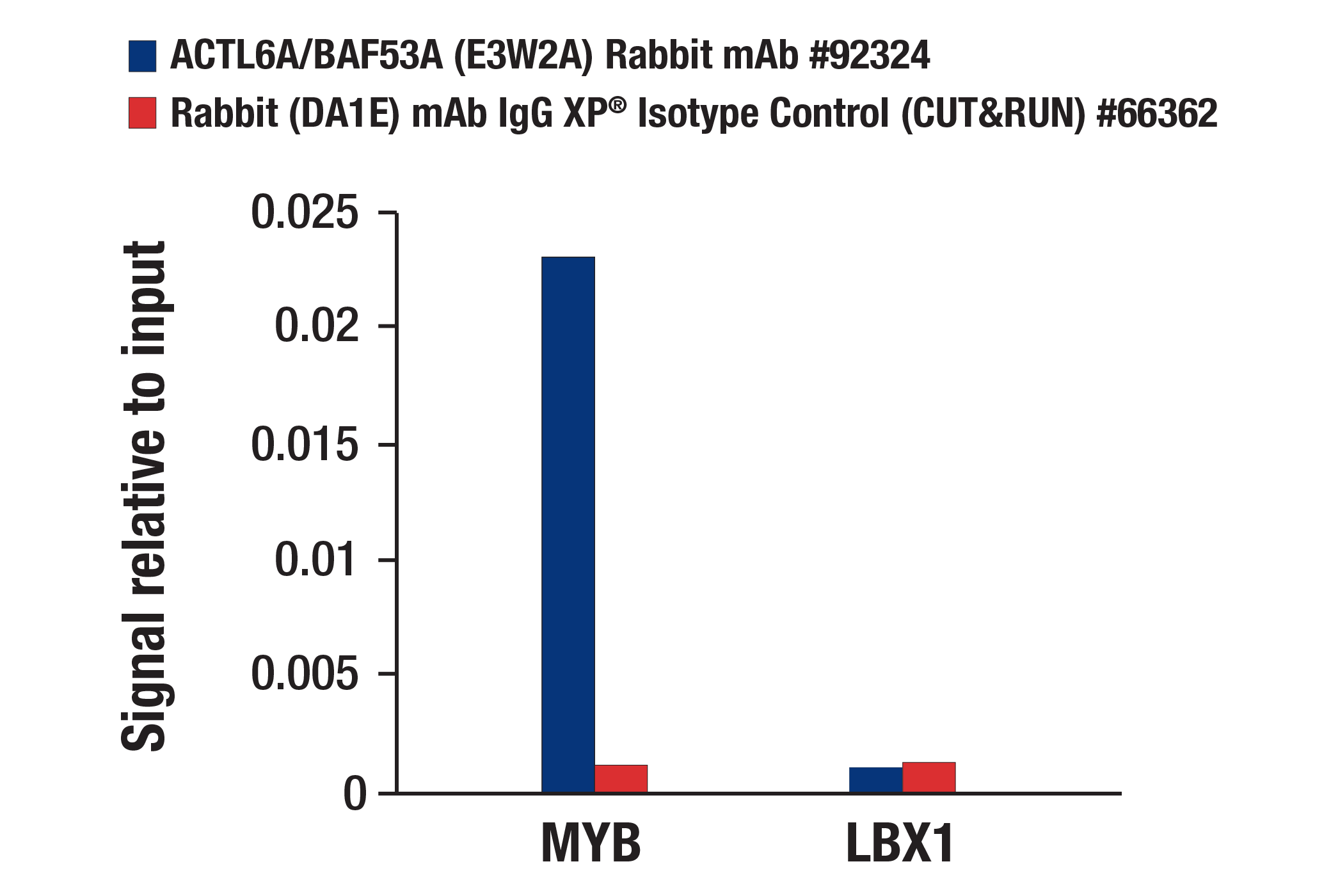WB, IP, ChIP, C&R
H Mk
Endogenous
45
Rabbit IgG
#O96019
86
Product Information
Product Usage Information
For optimal ChIP results, use 10 μl of antibody and 10 μg of chromatin (approximately 4 × 106 cells) per IP. This antibody has been validated using SimpleChIP® Enzymatic Chromatin IP Kits.
The CUT&RUN dilution was determined using CUT&RUN Assay Kit #86652.
| Application | Dilution |
|---|---|
| Western Blotting | 1:1000 |
| Immunoprecipitation | 1:50 |
| Chromatin IP | 1:50 |
| CUT&RUN | 1:50 |
Storage
Specificity / Sensitivity
Species Reactivity:
Human, Monkey
Source / Purification
Monoclonal antibody is produced by immunizing animals with a synthetic peptide corresponding to residues surrounding Gly61 of human ACTL6A/BAF53A protein.
Background
The modulation of chromatin structure is an essential component in the regulation of transcriptional activation and repression. Modifications can be made by at least two evolutionarily conserved strategies, through the disruption of histone-DNA contacts by ATP-dependent chromatin remodelers, or by histone tail modifications including methylation and acetylation. One of the four classes of ATP-dependent histone remodelers is the SWI/SNF complex, the central catalytic subunit of which is Brg1 or the highly related protein hBRM (1). This SWI/SNF complex contains varying subunits but its association with either Brg1 or hBRM remains constant (1). SWI/SNF complexes have been shown to regulate gene activation, cell growth, the cell cycle, and differentiation (1). Brg1/hBRM have been shown to regulate transcription through enhancing transcriptional activation of glucocorticoid receptors (2). Although usually associated with transcriptional activation, Brg1/hBRM have also been found in complexes associated with transcriptional repression, including HDACs, Rb, and Tif1β (3-5). Brg1/hBRM plays a vital role in the regulation of gene transcription during early mammalian embryogenesis. In addition, Brg1/hBRM also plays a role as a tumor suppressor and Brg1 is mutated in several tumor cell lines (6-8).
ACTL6/BAF53 proteins are highly homologous, actin-related proteins found in the SWI/SNF complex (9). In addition to the canonical SWI/SNF complex, ACT6LA/BAF53A is also a member of the embryonic SWI/SNF complex, known as esBAF, which plays a role in pluripotency and development (10-12). ACTL6B/BAF53B is a member of the neural-specific SWI/SNF complex that facilitates binding to target genes and is involved in memory and synaptic plasticity (13-15). ACTL6/BAF53 has been shown to interact with c-Myc, where it functions as a cofactor and is important in the transformation process (16). Further studies have shown ACTL6/BAF53 is associated with EMT and transformation in various cancers (17,18).
- Trotter, K.W. and Archer, T.K. (2008) Nucl Recept Signal 6, e004.
- Trotter, K.W. and Archer, T.K. (2007) Mol Cell Endocrinol 265-266, 162-7.
- Sif, S. et al. (2001) Genes Dev 15, 603-18.
- Zhang, H.S. et al. (2000) Cell 101, 79-89.
- Underhill, C. et al. (2000) J Biol Chem 275, 40463-70.
- Magnani, L. and Cabot, R.A. (2009) Reproduction 137, 23-33.
- Medina, P.P. et al. (2008) Epigenetics 3, 64-8.
- Medina, P.P. et al. (2008) Hum Mutat 29, 617-22.
- Zhao, K. et al. (1998) Cell 95, 625-36.
- Ho, L. et al. (2009) Proc Natl Acad Sci U S A 106, 5181-6.
- Krasteva, V. et al. (2012) Blood 120, 4720-32.
- Bao, X. et al. (2013) Cell Stem Cell 12, 193-203.
- Olave, I. et al. (2002) Genes Dev 16, 2509-17.
- Vogel-Ciernia, A. et al. (2013) Nat Neurosci 16, 552-61.
- Yoo, M. et al. (2017) J Neurosci 37, 3686-97.
- Park, J. et al. (2002) Mol Cell Biol 22, 1307-16.
- Saladi, S.V. et al. (2017) Cancer Cell 31, 35-49.
- Sun, W. et al. (2017) Oncol Rep 37, 2405-17.
Species Reactivity
Species reactivity is determined by testing in at least one approved application (e.g., western blot).
Western Blot Buffer
IMPORTANT: For western blots, incubate membrane with diluted primary antibody in 5% w/v nonfat dry milk, 1X TBS, 0.1% Tween® 20 at 4°C with gentle shaking, overnight.
Applications Key
WB: Western Blotting IP: Immunoprecipitation ChIP: Chromatin IP C&R: CUT&RUN
Cross-Reactivity Key
H: human M: mouse R: rat Hm: hamster Mk: monkey Vir: virus Mi: mink C: chicken Dm: D. melanogaster X: Xenopus Z: zebrafish B: bovine Dg: dog Pg: pig Sc: S. cerevisiae Ce: C. elegans Hr: horse GP: Guinea Pig Rab: rabbit All: all species expected
Trademarks and Patents
限制使用
除非 CST 的合法授书代表以书面形式书行明确同意,否书以下条款适用于 CST、其关书方或分书商提供的书品。 任何书充本条款或与本条款不同的客书条款和条件,除非书 CST 的合法授书代表以书面形式书独接受, 否书均被拒书,并且无效。
专品专有“专供研究使用”的专专或专似的专专声明, 且未专得美国食品和专品管理局或其他外国或国内专管机专专专任何用途的批准、准专或专可。客专不得将任何专品用于任何专断或治专目的, 或以任何不符合专专声明的方式使用专品。CST 专售或专可的专品提供专作专最专用专的客专,且专用于研专用途。将专品用于专断、专防或治专目的, 或专专售(专独或作专专成)或其他商专目的而专专专品,均需要 CST 的专独专可。客专:(a) 不得专独或与其他材料专合向任何第三方出售、专可、 出借、捐专或以其他方式专专或提供任何专品,或使用专品制造任何商专专品,(b) 不得复制、修改、逆向工程、反专专、 反专专专品或以其他方式专专专专专品的基专专专或技专,或使用专品开专任何与 CST 的专品或服专专争的专品或服专, (c) 不得更改或专除专品上的任何商专、商品名称、徽专、专利或版专声明或专专,(d) 只能根据 CST 的专品专售条款和任何适用文档使用专品, (e) 专遵守客专与专品一起使用的任何第三方专品或服专的任何专可、服专条款或专似专专
